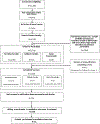A letter is not enough: Women's preferences for and experiences of receiving breast density information
- PMID: 35534300
- PMCID: PMC9250336
- DOI: 10.1016/j.pec.2022.03.014
A letter is not enough: Women's preferences for and experiences of receiving breast density information
Abstract
Objective: Despite evidence of disparate uptake of breast density (BD) information, little is known about diverse women's preferences for and experiences learning about BD.
Methods: Telephone survey among 2306 racially/ethnically and literacy diverse women; qualitative interviews with 61 survey respondents. Responses by participant race/ethnicity and literacy were examined using bivariate, then multivariable analyses. Interviews were content-analyzed for themes.
Results: Most women (80%) preferred learning of personal BD from providers, with higher rates among Non-Hispanic Black (85%) than Non-Hispanic White women (80%); and among Non-Hispanic White than Asian women (72%, all ps<0.05). Women with low literacy less often preferred receiving BD information from providers (76% v. 81%), more often preferring written notification (21% vs. 10%); women with high literacy more often preferred learning through an online portal (9% vs 3%). Most women (93%) received BD information from providers (no between group differences). Qualitative findings detailed women's desires for obtaining BD information from providers, written information, and visual depictions of BD.
Conclusions: When educating women about BD, one size does not fit all.
Practice implications: Additional educational methods are needed beyond written BD notifications to sufficiently address the varying informational needs and preferences of all USA women.
Keywords: Breast density notification; Health literacy; Patient experiences; Patient preferences; Racial/ethnic minorities.
Copyright © 2022 Elsevier B.V. All rights reserved.
Similar articles
-
Women's Understandings and Misunderstandings of Breast Density and Related Concepts: A Mixed Methods Study.J Womens Health (Larchmt). 2022 Jul;31(7):983-990. doi: 10.1089/jwh.2021.0343. Epub 2022 Feb 28. J Womens Health (Larchmt). 2022. PMID: 35230164 Free PMC article.
-
Influences of race and breast density on related cognitive and emotion outcomes before mandated breast density notification.Soc Sci Med. 2016 Nov;169:171-179. doi: 10.1016/j.socscimed.2016.09.037. Epub 2016 Oct 10. Soc Sci Med. 2016. PMID: 27733299 Free PMC article.
-
Breast Density Awareness and Knowledge in a Mammography Screening Cohort of Predominantly Hispanic Women: Does Breast Density Notification Matter?Cancer Epidemiol Biomarkers Prev. 2021 Oct;30(10):1913-1920. doi: 10.1158/1055-9965.EPI-21-0172. Epub 2021 Aug 4. Cancer Epidemiol Biomarkers Prev. 2021. PMID: 34348958 Free PMC article.
-
The Impact of Breast Density Information or Notification on Women's Cognitive, Psychological, and Behavioral Outcomes: A Systematic Review.J Natl Cancer Inst. 2021 Oct 1;113(10):1299-1328. doi: 10.1093/jnci/djab016. J Natl Cancer Inst. 2021. PMID: 33544867 Free PMC article.
-
The impact of legislation mandating breast density notification - Review of the evidence.Breast. 2018 Dec;42:102-112. doi: 10.1016/j.breast.2018.09.001. Epub 2018 Sep 11. Breast. 2018. PMID: 30236594 Free PMC article. Review.
Cited by
-
Screening mammography frequency following dense breast notification among a predominantly Hispanic/Latina screening cohort.Cancer Causes Control. 2024 Aug;35(8):1133-1142. doi: 10.1007/s10552-024-01871-7. Epub 2024 Apr 12. Cancer Causes Control. 2024. PMID: 38607569
-
Perceptions of Breast Cancer Risks Among Women Receiving Mammograph Screening.JAMA Netw Open. 2023 Jan 3;6(1):e2252209. doi: 10.1001/jamanetworkopen.2022.52209. JAMA Netw Open. 2023. PMID: 36689223 Free PMC article.
References
-
- Cappello NM. Decade of ‘normal’ mammography reports--the happygram. J Am Coll Radiol: JACR 2013. Dec;10(12):903–8. - PubMed
-
- DenseBreast-Info.org. DenseBreast-Info.org. 2021. [cited 2021 June 22]; Available from: https://densebreast-info.org/.
-
- Kressin NR, Gunn CM, Battaglia TA. Content, Readability, and Understandability of Dense Breast Notifications by State. J Amer Med Assoc 2016. Apr 26;315(16):1786–8. - PubMed
Publication types
MeSH terms
Grants and funding
LinkOut - more resources
Full Text Sources


